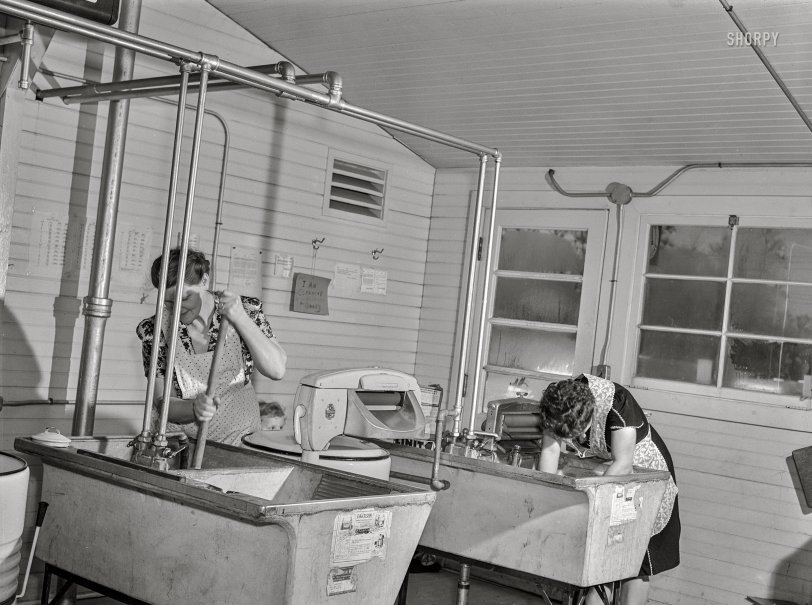


Framed or unframed, desk size to sofa size, printed by us in Arizona and Alabama since 2007. Explore now.
Shorpy is funded by you. Patreon contributors get an ad-free experience.
Learn more.

- Lofty addition
- In 1912
- Keenan Building
- Six years old
- Taken from the P.J. McArdle Roadway?
- It stood only 47 years
- Three track mind
- Incline to the right
- Reach for the sky, 1912 style
- No clean sweep
- Same Job Title, Same Face
- Sadly Lost
- Beautiful ...
- Where you get your kicks
- Aim High
- Pueblo Revival sisters
- Pueblo Neoclassicism
- Milk Man
- Regional dialect.
- Spielberg's inspiration
- Great Photo
- Loaf Story
- Do you still have the Rakes category?
- Could almost be a scene from the 1957 movie 'Hell Drivers'
- The Wages of Fear.
- Conspicuous by their absence
- Got Milk?
- All that aluminum
- No lefties
- Smoke 'em if you've got 'em
Print Emporium
Granitine: 1942

February 1942. "Burlington, Iowa. Acres Unit, Farm Security Administration trailer camp. In the utility building for workers at Burlington ordnance plant." Home of the Granitine Laundry Tray. Acetate negative by John Vachon for the Office of War Information. View full size.
Alert supervisor
The rest of the community was hopefully as blessed as these two laundresses by the presence of such charming overseers as the one peeking at the wringer of the washing machine.
I spent a little time watching an aunt use one of these and it always frightened me after being warned not to get myself caught in it. I ceased to be fearful when my mom got a mangle to press my dad's uniforms in.
Justice will be served
We who watched the 1960s Batman TV show know what it means when the camera is tilted in this fashion.
Soon the Caped Crusaders will break into the frothy lair of the sinister Suds Sisters and their young sidekick and sincerely kick their butts.
"Holy mangle, Batman!!!"
Peek-a-Boo!
A small face is peeking above the washing machine. Watch those fingers in that wringer!
It's not a chore, it's backbreaking work
Anybody wonder why GE, Hoover et al and their hosehold appliances were all the rage after WW2?
Two Wringer Washers and One Wringer
There are two wringer washing machines to the left, and on the right what appears to be a wringer attached to the top of the divider between the two concrete laundry tubs. While the electric machines would have powered wringers, the other one where the lady is bent over may well have been operated with a hand crank. This would be an advantage for delicate items that might be damaged in a powered wringer. For clothes in water too hot to handle, an old cut off broom handle could be used, which is what the lady on the left might be doing.
By 1951 automatic washers outsold wringers in the USA, a point that Canada did not reach until 1968. When I moved out on my own in Vancouver in 1967, my apartment building had three wringer washers until 1971.
I remember those
In 1947 when I was a kid my family moved into a 1941 vintage home that had a laundry tray just like those in the image. It was complete with the same built in washboard.
However we had progressed beyond the wringer washer and had a newfangled "EASY Spindrier" washing machine with two tubs. One tub had an agitator similar to the agitator in today's top loading washers. After the washing process was completed the clothes were manually transferred to the second slightly smaller tub that would spin to eliminate most of the water. The next step was to hang the clothes on an outside clothes line and let mother nature's wind and Sun complete the drying process. If the weather didn't cooperate then the clothes were hung on lines in the basement.
https://a.1stdibscdn.com/archivesE/upload/1121227/f_3585313/3585313_l.jp...
Those Washboard Blues
Notice the built-in washboard on the front of the left-hand basins. The woman on the far side is bent over it, scrubbing away. Sometimes we forget how exhausting everyday domestic life must have been even in the '40s.
Listing to Starboard
And somehow that seems appropriate. The moms are working hard, probably without sufficient thanks from the people whose clothes they are scrubbing. The tilt of the photo helps me to emphasize empathize with their fatigue.
Through the Wringer
My mom put her arm through one of those wringers that the child is eying somewhere around that same time in the 1940's. The effect of the flattening sort of disappeared when she was younger but you can literally see the damage it did to her arm nowadays.
























On Shorpy:
Today’s Top 5